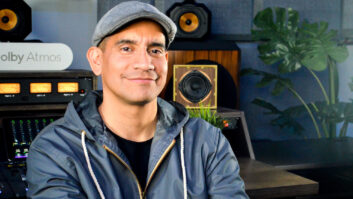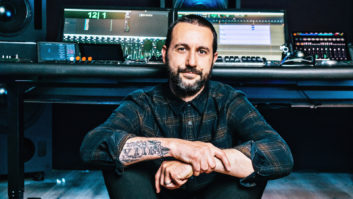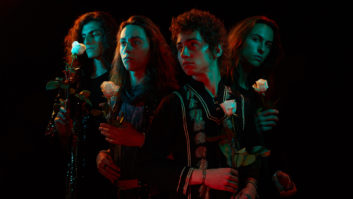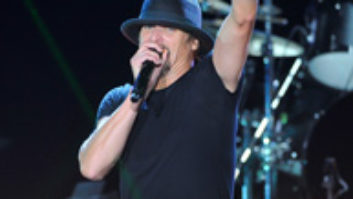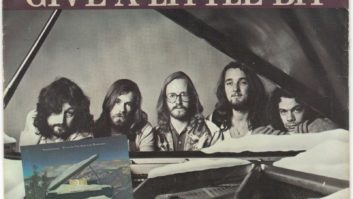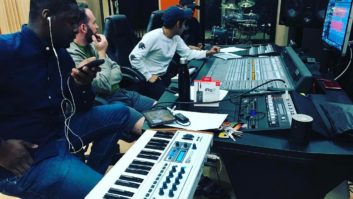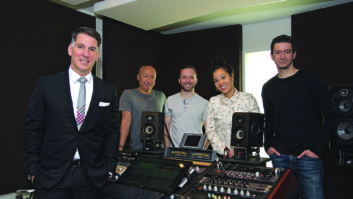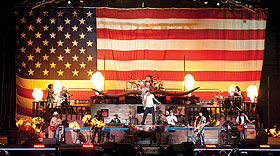
Kid Rock and band performing
Kid Rock may have stormed onto the music scene in the late ’90s as a rapper with a Southern edge, but during the intervening years, he’s added rock, country, gospel and many other nuances to his performance. Touring in support of his latest, Born Free, Kid Rock (with a couple of songs with Sheryl Crow) rocked the house at the Sleep Train Amphitheater (Wheatland, Calif.), where Mix caught up with the Sound Image–provided tour.

Systems tech John Tompkins (left) and FOH engineer Steve Cross
When front-of-house engineer Steve Cross joined the tour in the fall of 2007, it was an extended promo run hitting clubs and theaters. Cross mans an Avid Profile, citing its size as a primary reason in choosing the desk. “From day one, it was clear that I had made a good choice,” Cross says. “Kid Rock’s Twisted Brown Trucker band grew from a 5-piece to a 10-piece in the first two days of rehearsal. I currently run 81 input channels and a host of effects and never have to reach more than arm’s length. It allows me to concentrate on the music mix—not the technical side of what’s in front of me.”
Onboard effects include Avid ReVibe for all reverbs. “It is versatile enough for all my needs in this show. With the exception of one ‘effect’ verb, I try to keep all the verbs for the vocals and instruments very similar in type and decay. If I move from a large hall to a plate verb, I make that change for all verbs and then tailor the times to get them to layer nicely with each other. Another plug-in I use a lot is the Crane Song Phoenix. It has a nice way of bringing things forward in a mix without simply turning them up. Other than that, there are lots of delay cues that use the Avid delay. I use channel compression where needed, but no compressor plug-ins at all.”
Cross is also doing redundant recording, using Pro Tools of each show with stem mixes and audience mics; a DVD has the stereo and audience feed, with all stems and feeds coming from the Profile.
“Kid Rock is a bit of an oddity for a mixer in that he is not any one thing: metal, rap, rock, country, bluegrass, gospel. He expects his country songs to sound country. Smooth rhythm section with a twangy lead. And his hip-hop stuff, he wants to punch you in the face and rumble your seat. I do my best to constantly evolve the mix as he arranges the show. The show is constantly being re-tooled, re-arranged and mashed up with every song that ever inspired him. This mix is the most demanding I have had in my career.”

From left: P.A./stage tech Andrew Cauley, monitor engineer Beau Alexander and monitor tech Vince Luchetta
Monitor engineer Beau Alexander is also on an Avid Profile. “Using this console makes my footprint very minimal,” Alexander says. “I’m not using any plug-ins; they would prefer to hear everything dry and not effected.” Comps and gates are also onboard. Alexander reports that the radio systems are Shure U4RD for wireless mics, saxophonist Dave McMurray’s Shure clip-on mic attached to an instrument wireless pack and for all wireless piano channels. IEMs are eight channels of Shure 900 systems. Onstage wedges are Sound Image Double 12s.
Stefanie Eulinberg’s drum kit is miked with a Shure SM57 on snare top/bottom; Audix D6 in the kick; and AKG 414s for hi-hat, overheads, ride cymbal, chimes, cowbells and gong. Her vocal mic is a Shure Beta 57, “well-suited for rejecting drums and capturing a good female vocal sound,” says drums/keys tech Mark Messina.
Keyboardist Jimmie Bones plays a Kurzweil SP-2 and PC-3 (pictured), Triton Extreme and Hammond B3. Kid Rock’s grand piano is wireless to help move it quickly on- and offstage. “It is an inserted keyboard with a car battery and two Shure wireless packs,” explains drums/keys tech Mark Messina.
According to DJ/percussion tech Casey Long, DJ Freddie “Paradime” Beauregard’s equipment comprises a Macbook Pro with Serato, two Technics SL1200k5, a Rane TTM 57SL mixer, MPC 4000, instant replay, Pioneer DVJ 1000, APC Pro1500, and a shaker and tambourine.
Lead guitarist Marlon Young’s amps include a Fender Twin and Deluxe, and a Marshall Tremolo 50-watt. All amps are miked with a Shure KMS32: one on the Twin, one on the Deluxe and a stereo pair on the 4×12 Marshall cab (pictured). According to guitar tech Al Rogozinski, Young’s foot pedalboard comprises a dual-amp switcher, MXR Carbon Copy and Phase 90, Mercury 3 Harmonic Boost, Boss distortion and tuner, Ibanez Tube Screamer, Fulltone OCD and Clyne.
Stage-left guitarist Jason Krause uses custom-made Diamond 100W Phantom amps and Diamond cabinets. “We use a stereo setup on Jason’s rhythm guitars by putting two KSM32s on him and spreading them wide,” says guitar/bass tech John Cromer. “It gives us a huge rhythm bed to mix with.” Bassist Aaron Julison uses Ashdown Evo lll 900W amps and Ashdown cabinets, miked with Audio-Technica AE2500s.
Percussionist Larry Frantangelo’s instruments are miked with Shure SM98s and AKG 414s.
